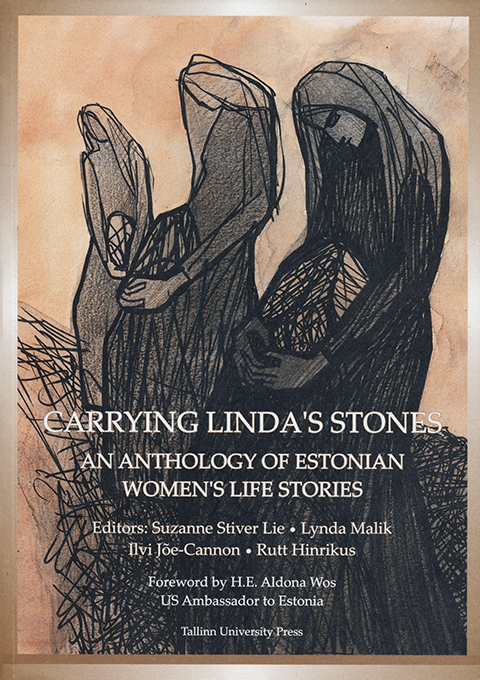“Tassimas Linda kive: eesti naiste elulugude antoloogia” (Carrying Linda’s Stones: An Anthology of Estonian Women’s Life Stories) sisaldab viieteistkümne ajaloo hoovustesse sattunud Eesti naise jutustusi. Elulood on kaasaegseks illustratsiooniks sajanditepikkusele võõrvägede invasioonile ning valitsemisele, keskendudes kahekümnenda sajandi teisele poolele – hõlmates endas perioodi Teisest maailmasõjast ja nõukogude okupatsioonist kuni iseseisvusele üleminekuni.
Elulood hõlmavad endas kolme erineva kogemusega gruppi: 1) suuresti läbiuurimata eestlaste populatsioon, kes jäid nimetatud perioodi vältel Eestisse 2) inimesed, kes deporteeriti massirepressioonide käigus Siberisse 1941. ja 1949. aastal ning Saksamaale natsiokupatsiooni ajal ning 3) need, kes põgenesid Nõukogude okupatsiooni eest Läände.
Raamat on inglise keeles ning eessõna on kirjutanud Aldona Wos, USA suursaadik Eestis. Toimetanud Suzanne Stiver Lie, Lynda Malik, Ilvi Jõe-Cannon, Rutt Hinrikus.
Väljaandja Eesti Naisuurimus- ja Teabekeskus (ENUT) koostöös Tallinna Ülikooli Kirjastusega
Väljaanne on müügil ENUTis. Vaata lähemalt
Arvustus
Carrying Linda s Stones is a significant study of women’s lives that speaks powerfully to those of us who have been touched by the Soviet occupation and the Estonian diaspora. The editors of this volume have given voice to 15 women and by extension to many thousands of others who had similar experiences that have not been documented. Since it is the first study of its kind to be published in English, these voices can now be heard around the world. My own mother fled Estonia with her family in 1944 as the second Soviet occupation began. She traveled on a German troop transport ship and then on foot across Germany to reach a displaced person s camp in Hamburg. She and her roommates pursued graduate education while living in the camp and when these women came to the United States, all four had professional careers that spanned three decades. My mother is one of the thousands of courageous Estonian women that Carrying Linda s Stones seeks to make visible. This book draws on the life history collection of the Estonian Literary Museum Cultural History Archive and the editors have carefully selected and translated life stories that represent those who stayed in Estonia to lead a double life under the occupation, those who were forcibly deported, and those who decided to flee and live in exile. The stories themselves are compelling; however, the greater importance of this volume lies in its historical contextualization and sociological analysis of these memories. Evidencing both sociological imagination and a feminist perspective, this study looks at the intersection of biography and history with an eye to revealing the forces of gender inequality that shaped Estonian women s lives. All Estonians were profoundly affected by the political and military struggle between Germany and Russia for control of Estonia during World War II, the Soviet occupation, as well as the ongoing development of Estonian nationalism. Carrying Linda s Stones illuminates how these socio-political forces affected women s lives in particular. Especially significant is the powerful and fascinating tension between Estonian national identity on the one hand and gender equality on the other. Although Estonian women won the right to vote in 1920 at the beginning of the first independence period, they were barely represented within the new democracy and the emphasis on national identity founded on a strong family kept women mired in traditional gender roles. The Soviet imposition of a pseudo-equality during the half century of occupation did little to lighten women s burdens while it managed to taint ideas of gender equality and feminism. I do have some quibbles with the editing of the volume, particularly the redundancy of the organization of historical materials. A number of chapters cover the same historical periods and that tends to make the book a bit choppy. Minor problems notwithstanding, Carrying Linda s Stones makes a valuable contribution to Baltic Studies. Baltic Studies, like other scholarly fields, has been limited by its focus on political, economic and military issues framed overwhelmingly from a male perspective. Women s lives have been invisible and women s voices silent. Carrying Linda s Stones is an important step in bringing women into Baltic Studies. Further, because it is written in English, it brings the powerful stories of Estonian women to a broader audience interested in the relationship between national identity and gender equality.
— Kersti Yllo
2007
Wheaton College, Norton, MA
Journal of Baltic Studies, 8 January 2008

